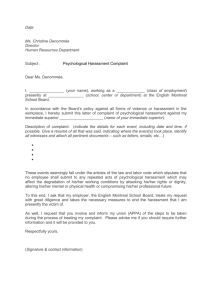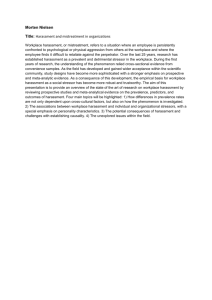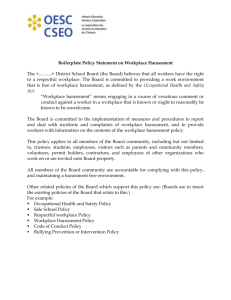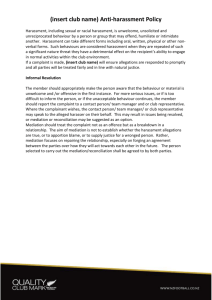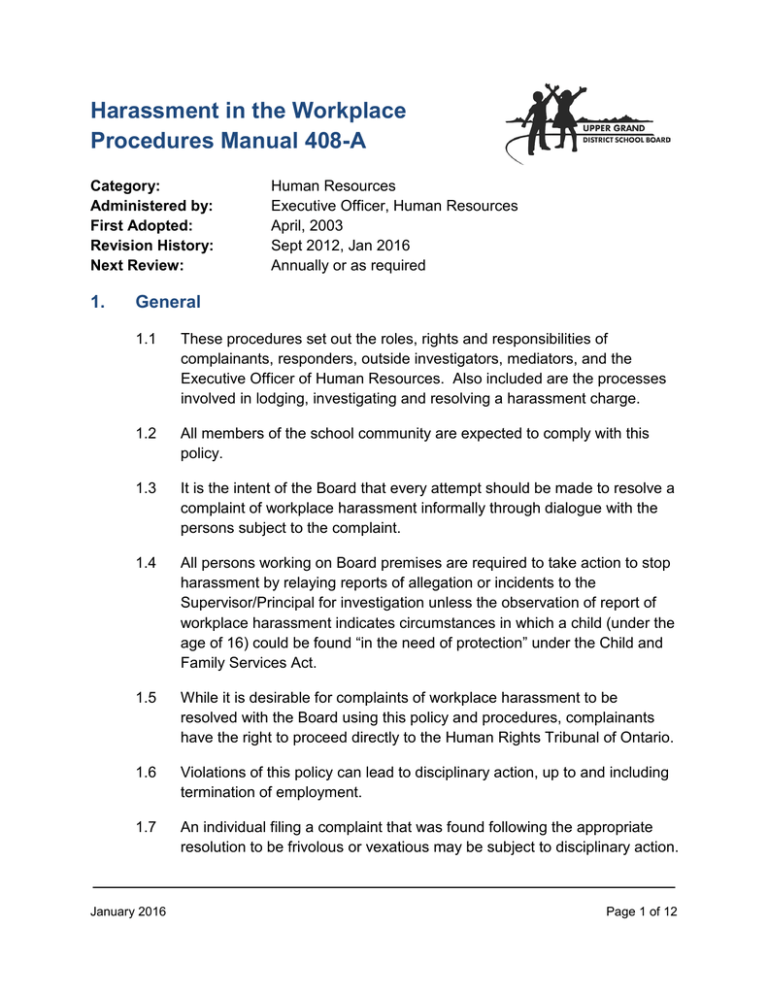
Harassment in the Workplace
Procedures Manual 408-A
Category:
Administered by:
First Adopted:
Revision History:
Next Review:
1.
Human Resources
Executive Officer, Human Resources
April, 2003
Sept 2012, Jan 2016
Annually or as required
General
1.1
These procedures set out the roles, rights and responsibilities of
complainants, responders, outside investigators, mediators, and the
Executive Officer of Human Resources. Also included are the processes
involved in lodging, investigating and resolving a harassment charge.
1.2
All members of the school community are expected to comply with this
policy.
1.3
It is the intent of the Board that every attempt should be made to resolve a
complaint of workplace harassment informally through dialogue with the
persons subject to the complaint.
1.4
All persons working on Board premises are required to take action to stop
harassment by relaying reports of allegation or incidents to the
Supervisor/Principal for investigation unless the observation of report of
workplace harassment indicates circumstances in which a child (under the
age of 16) could be found “in the need of protection” under the Child and
Family Services Act.
1.5
While it is desirable for complaints of workplace harassment to be
resolved with the Board using this policy and procedures, complainants
have the right to proceed directly to the Human Rights Tribunal of Ontario.
1.6
Violations of this policy can lead to disciplinary action, up to and including
termination of employment.
1.7
An individual filing a complaint that was found following the appropriate
resolution to be frivolous or vexatious may be subject to disciplinary action.
January 2016
Page 1 of 12
HARASSMENT IN THE WORKPLACE
PROCEDURES MANUAL 408-A
2.
Definitions
These definitions are not intended to limit interactions or relationships based on
mutual consent, nor do they refer to normal social contact between employees.
Workplace harassment does not include the normal direction, counselling,
training, evaluation or discipline involved in carrying out the responsibilities and
rights of the supervisor/administrator.
While each (reported) incident of workplace harassment will be examined on an
individual basis, the following definitions will generally apply.
Workplace Harassment
Workplace Harassment is defined by the Occupational Health and Safety Act
(OHAS) as “engaging in a course of vexatious comment or conduct against a
worker in a workplace that is known or ought reasonably to be known to be
unwelcome”. Workplace harassment includes sexual harassment and
racial/ethno-cultural harassment as defined below.
Sexual Harassment
Sexual harassment is inappropriate verbal or physical conduct of a sexual nature
which is known or ought to be known as offensive or degrading. It includes but is
not limited to:
January 2016
•
sexual solicitation or advance made by a person in a position to grant,
confer sexually offensive or degrading words, suggestive comments,
obscene comments or gestures
•
a reprisal or threat of reprisal for the rejection of a sexual solicitation or
advance where the reprisal is made or threatened by a person in a
position to grant, confer, or deny a benefit or advantage to the person
•
sexual jokes when they are clearly offensive or degrading
•
the display and/or distribution especially by any electronic medium of
sexually offensive or degrading material, derogatory remarks directed
toward members of one sex or sexual orientation
•
sexually offensive or degrading words, suggestive comments, obscene
comments or gestures
•
derogatory remarks directed towards members of one sex or sexual
Page 2 of 12
HARASSMENT IN THE WORKPLACE
PROCEDURES MANUAL 408-A
orientation
•
unwelcome sexual flirtations, leering, advances, propositions, gifts or
requests for sexual favours
•
unwanted touching
•
verbal abuse or threats of sexual nature
•
sexual assault
Racial/Ethno-cultural Harassment
Such workplace harassment involves any action that ridicules, degrades or
expresses hatred or undue attention based on race, ethnic group, skin colour,
language, dress or religion. It includes, but is not limited to:
3.
•
demeaning comments, unwelcome remarks, jokes, innuendoes or
taunting about a person's group, race, ancestry, place of origin, colour,
ethnic origin, citizenship or creed
•
the display and/or distribution, especially by any electronic medium, of
racist, derogatory, or offensive pictures or material
•
the production and distribution of hate literature using any media form
including the electronic media
•
exclusion because of one's racial, ethnic or religious background
•
slurs and remarks about a group meant to demean and degrade that
group in the presence of an individual (not necessarily a member of the
group mentioned) that create a poisoned environment
•
threats, abuse, or assault
General Rights and Responsibilities
3.1
January 2016
A party to a complaint has the right to:
•
be heard in an unbiased manner and to be taken seriously
•
confidentiality to the extent possible
•
know the names of the individual parties to the complaint and the
appointed investigator
Page 3 of 12
HARASSMENT IN THE WORKPLACE
PROCEDURES MANUAL 408-A
3.2
3.3
3.4
3.5
January 2016
A complainant has the right, in addition to those in 3.1 above to:
•
seek assistance and support
•
have the allegation taken seriously and to be assured that all
efforts will be made to investigate the allegation in a fair and
expedient manner
•
be informed of decisions to the extent possible that appropriate
corrective action has been taken
•
protection from reprisal or threat of reprisal
A respondent has the right in addition to the rights noted in 3.1 above to:
•
seek assistance and support
•
respond to the allegations
•
know the identity of the complainant
•
know the details of the complaint
•
protection from being prejudged
It is the responsibility of a complainant to:
•
report the concern to a supervisor, teacher, or union official
•
bring forth information in a timely fashion that is an accurate
account/description of the alleged incident(s)
•
maintain confidentiality
•
co-operate with the individual(s) involved in the complaint and the
resolution process
•
report any further occurrence of workplace harassment, or
reprisal, or threat of reprisal
It is the responsibility of the respondent to:
•
bring forth information in a timely fashion that is an accurate
account/description of the alleged incident(s)
•
maintain confidentiality
Page 4 of 12
HARASSMENT IN THE WORKPLACE
PROCEDURES MANUAL 408-A
4.
•
co-operate with the individual(s) involved with the complaint and
the resolution process
•
refrain from reprisal or threats of reprisal
Procedures
An individual has the right, based on observed events, to lodge a complaint of
workplace harassment with the Board, without fear of reprisal or threat of reprisal
for doing so.
4.1
Allegations of Workplace Harassment: Employee(s) by Employee(s)
Note: All information obtained and actions taken must be
documented in writing.
An employee who feels that he/she has been the subject of workplace
harassment should do the following:
January 2016
4.1.1
Tell the harasser that his/her behaviour is unwelcome and to stop.
4.1.2
Keep records of incidents in as much detail as possible. Record
dates, times, locations, possible witnesses, what happened, and
your reaction in as much detail as possible. It is not necessary to
have a record of events to file a complaint, but it can help
remember details.
4.1.3
If the behaviour does not stop immediately, the individual does not
feel comfortable approaching the alleged harasser or the
behaviour was of such a nature that it causes the individual
ongoing discomfort, the individual should contact one of the
following who will attempt to resolve the issue or advise the
individual of their right to file a formal complaint:
•
a Principal or supervisor
•
a supervisor’s supervisor
•
a union or association representative
•
a Superintendent/Senior Administrator,
•
the Director if the concern involves a
Superintendent/Senior Administrator
Page 5 of 12
HARASSMENT IN THE WORKPLACE
PROCEDURES MANUAL 408-A
4.1.4
To lodge a formal complaint, the complainant sends a written and
signed complaint form (Form 408-1 Workplace Harassment
Report Form) to the Executive Officer, Human Resources
identifying the nature of the workplace harassment and other
particulars. The Executive Officer, Human Resources determines
whether the complaint falls within this policy and if so, ensures
that a copy of the complaint is sent to the respondent.
4.1.5
The respondent shall have ten (10) working days to provide a
written response to the complaint.
4.1.6
Within ten (10) working days of the complaint being filed, the
Executive Officer, Human Resources, appoints an investigator.
The investigator may be an individual from another Board or
agency, or a staff member with administrative responsibilities,
such as a Principal or Superintendent. The investigator should
have received training to conduct an investigation.
4.1.7
The investigator will make contract with the parties and initiate the
investigation within ten (10) working days of being appointed.
4.1.8
The investigator will:
4.1.9
January 2016
4.1.8.1
meet with the complainant to clarify the complaint and
obtain additional information and will obtain a signed
written statement from the complainant
4.1.8.2
after meeting with the complainant, meet with the
respondent and give him or her an opportunity to
respond to the allegations and will obtain a signed,
written statement from the respondent
4.1.8.3
interview any witnesses with relevant information
regarding the complaint and obtain signed, written
witness statements
At any time prior to or during the investigation process, mediation
can be an effective and efficient method of complaint resolution
that maintains the dignity of the parties and is consistent with the
spirit of the Ontario Human Rights Code.
Page 6 of 12
HARASSMENT IN THE WORKPLACE
PROCEDURES MANUAL 408-A
4.1.10 If the parties agree to mediation, the Executive Officer, Human
Resources shall appoint a neutral mediator who shall attempt to
resolve the matter.
4.1.11 Should mediation resolve the matter, the mediator shall prepare a
Settlement Document outlining the details of the resolution. The
parties and the Executive Officer, Human Resources will sign the
report. Any discipline resulting from the document will be noted
and the copy will be placed in the individual’s H01 (personnel) file.
4.1.12 If mediation is unsuccessful the investigator shall prepare a
written report of the findings of fact and a summary of the findings,
and submit them to the Executive Officer, Human Resources. The
summary of the findings shall be sent to the complainant and the
respondent.
4.1.13 The Executive Officer of Human Resources may, at his/her
discretion, facilitate an informal meeting with the parties to discuss
the findings of the report.
4.1.14 Should discussion at this stage resolve the matter, the Executive
Officer, Human Resources shall prepare a Settlement Document
which outlines the details of the resolution. The parties and the
Executive Officer, Human Resources shall sign the document.
Any discipline resulting from the report will be noted and a copy
will be placed in the individual’s H01 file.
4.1.15 If mediation is not possible, the Executive Officer, Human
Resources shall prepare a written decision outlining the findings,
disciplinary actions, if any, and other non-disciplinary actions such
as education and training as necessary. Disciplinary actions may
include, but are not limited to:
January 2016
•
requiring the harasser to apologize in writing, and/or in
person
•
requiring the harasser to seek counseling through the
Employee Assistance Program or other service provider
•
disciplinary letter placed in the employee’s H01 file
•
suspending the harasser from work with or without pay,
Page 7 of 12
HARASSMENT IN THE WORKPLACE
PROCEDURES MANUAL 408-A
and/or
•
terminating the employment of the harasser
If the complaint is found to be vexatious or improperly motivated
the complainant may be subject to the sanctions noted above.
4.1.16 The decision report should be prepared within thirty (30) days of
the receipt of the investigation report, and should be held in the
confidential workplace harassment files of the Executive Officer,
Human Resources and shared with the parties as appropriate.
4.1.17 An individual who has been disciplined as a result of these
proceedings, may request recourse after a period of not less than
two (2) years, to have the disciplinary letter, if any, removed from
the H01 file. The decision of the Executive Officer, Human
Resources in this regard, is final.
4.2
Allegations of Workplace Harassment: Employee(s) by Student(s)
Note: All information obtained and actions taken must be
documented in writing.
January 2016
4.2.1
Employees who believe a student has harassed them should
report the incident(s) to the Principal or immediate supervisor who
will report the incident to the Principal.
4.2.2
Upon receiving a formal complaint the Principal shall conduct an
immediate investigation into the incident(s). The processes of
procedural fairness should guide the investigation. To ensure
procedural fairness the respondent will be provided with an
opportunity to know the allegations made against him/her (and the
name of the complainant), and an opportunity to respond to the
complaint. There will be an opportunity for each side to know the
outcome. Should it be determined that the student has harassed
the employee, the Principal shall refer to the Board’s policy #503
Safe Schools to determine the appropriate outcome.
Page 8 of 12
HARASSMENT IN THE WORKPLACE
PROCEDURES MANUAL 408-A
4.3.
Allegations of Harassment: Employee(s) by Other(s)
Note: All information obtained and actions taken must be
documented in writing.
4.3.1
Reporting
If an employee feels that he/she has been the subject of
workplace harassment by someone other than an employee or
student, he/she should report by contacting a Principal, Manager,
Superintendent, or union/association representative, who shall
advise the employee’s immediate supervisor.
4.3.2
Resolution
To attempt to resolve the situation, when the immediate
supervisor is informed of the situation he/she will obtain details of
the incident. In some circumstances, it may be prudent to attempt
to conduct an investigation of the complaint, to the extent
possible, give the nature of the relationship between the alleged
harasser and the Board. Where that is the case, the investigation
steps (noted in 4.1.8 Formal Complaint above) should be
followed. If it is found that workplace harassment has occurred,
the supervisor, in consultation with the appropriate senior
administrator or designate shall take whatever action is
appropriate to stop the harassment. Options may include, but are
not limited to:
January 2016
4.3.2.1
telling the person that his/her comments and or
behaviour is/are inappropriate and in contravention of
Board policy (and/or the Ontario Human Rights Code),
and that the harassment must stop
4.3.2.2
issuing a notice of trespass to the outsider and a
warning that the Police will be called if attempts are
made to enter the property
4.3.2.3
the Principal excluding a person from the school under
section 265(m) of the Education Act
Page 9 of 12
HARASSMENT IN THE WORKPLACE
PROCEDURES MANUAL 408-A
4.4
4.3.2.4
ensuring that the complainant has another staff member
present if he/she is required to interact with the individual
in the future (as in the case of workplace harassment
perpetrated by a parent or guardian)
4.3.2.5
requesting that a vendor or other service provider send a
different representative to conduct business on Board
property
4.3.2.6
contacting the Police in the case of a threatening
situation where there is concern for the safety of an
employee or others.
Allegations of Harassment: Student(s) by Other Student(s)
Note: All information obtained and actions taken must be
documented in writing.
4.4.1
A student who believes that he/she has been harassed by another
student should report the incident(s) to the Principal.
4.4.2
Upon receiving a formal complaint the Principal shall conduct an
immediate investigation into the incident(s). The processes of
procedural fairness should guide the investigation. Should it be
determined that the student has harassed another student, the
Principal shall refer to the Board’s Policy #503 Safe Schools to
determine the appropriate outcome.
To ensure procedural fairness, the respondent will be provided
with an opportunity to know the allegations made against him/her,
the name of the complainant and an opportunity to respond to the
complaint. There will be an opportunity for each side to know the
outcome.
4.5
Allegations of Harassment: Student(s) by Staff Member(s)
Note: All information obtained and actions taken must be
documented in writing.
4.5.1
January 2016
It is the responsibility of the Principal or Vice-Principal to
investigate all student complaints of workplace harassment by
staff. The student should be aware that the term “staff members”
Page 10 of 12
HARASSMENT IN THE WORKPLACE
PROCEDURES MANUAL 408-A
includes but is not limited to teachers, guidance counselors,
coaching staff, Principals and Vice-Principals, custodians and
secretaries. Workplace harassment may involve an abuse of
power if the student is coerced into granting favours to the staff
member. Coercion may be evidenced by actions such as threats
of receiving a low mark or a failing mark, or in the form of a
promise of a reward, special favour or receiving an unearned
passing grade or higher mark. Harassment may be persistent and
ongoing inappropriate comments, gestures or touching.
4.5.2
Any allegation of workplace harassment shall be taken seriously,
listened attentively to in a manner that does not humiliate or
degrade the student making the allegation. A student who
believes that he/she is/has been harassed by a staff member is to
take the following steps:
4.5.2.1
The student should report the harassment directly to the
Principal or Vice-Principal. Otherwise the student is to
tell someone whom he/she trusts at home and/or at the
school (parent/guardian, the school advisor, a classroom
teacher, guidance counselor, or any other adult in the
school) about the harassment as soon as possible. A
student may wish to take along a friend or support
person when reporting the incident(s).
4.5.2.2
The trusted adult shall report the alleged harassment to
the Principal/Vice-Principal.
Note: if the alleged harasser is the Principal or VicePrincipal, the complaint is to be made directly to the
Superintendent of Education.
4.5.3
January 2016
The Principal or Vice-Principal will notify the Superintendent of
Education of the alleged occurrence(s). The Superintendent of
Education will consult with Human Resources. Parents/Guardians
will be informed depending on the nature of the harassment and
based on the notification of victim’s parents as outlined in Board
Policy #503 Safe Schools. The Superintendent of Education and
the Executive Officer, Human Resources will oversee the Board’s
investigation as necessary.
Page 11 of 12
HARASSMENT IN THE WORKPLACE
PROCEDURES MANUAL 408-A
January 2016
4.5.4
The student will be asked to tell a person conducting the
investigation what happened in as much detail as possible. A
friend, peer, teacher or someone else may accompany him or her.
Witnesses will be interviewed independently. The alleged
harasser will have an opportunity to respond to the allegation, if
he/she so chooses.
4.5.5
The alleged harasser may be accompanied by a representative of
his/her association/union during the interview related to the
complaint. If the alleged harasser is not represented by a
union/association, he/she may be accompanied by a support
person.
4.5.6
The respondent has the right to make a written response to the
allegations including any additional claims that may be found
during the investigation.
4.5.7
The investigator shall prepare a report of the findings of facts, and
a summary of the findings and submit them to the Executive
Officer, Human Resources. The summary of the findings shall be
sent to the claimant and the respondent.
4.5.7
Consequences, including sanctions for a vexatious complaint or
disciplinary action for harassing behaviour may result.
4.5.8
The completed report shall be forwarded to the Human Resources
Department for filing in the confidential harassment files of the
Executive Officer, Human Resources.
Page 12 of 12

